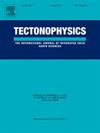墨西哥城地下缓慢滑动断层的相互作用在几个月内引发了强烈的地震活动
IF 2.7
3区 地球科学
Q2 GEOCHEMISTRY & GEOPHYSICS
引用次数: 0
摘要
2023年2月,墨西哥城西部发生了一场长时间的地震,造成了广泛的恐慌,并对住房基础设施造成了一些破坏。在5月11日和12月14日,两次Mw3.2主震发生在700米以下深度。前所未有的卫星干涉图捕捉到了地震前后几天两个震中地带的构造变形。数据分析显示,在两条相距800 m的近平行东西向正断层(即南部的Barranca del Muerto (BM)断层和北部的Mixcoac断层)上存在最大位移约8 cm的扩展滑动。详细的微震活动分析表明,BM断层上95%的滑动是地震性的,并且在5月11日地震前至少6天开始在位于震源以东1公里,深度约1.2公里的主陡岩上。对于12月发生在Mixcoac断层上的事件,约70%的滑动也是地震性的,但较浅(大部分在600米以上),这可以部分解释为BM断层5月滑动在该断层上引起的应力。定量的地貌学分析允许在埋藏断层和它们向西的地貌表达之间建立结构联系,在最强烈地震活动集中的丘陵地区,地表延伸~ 3.5和~ 4.5公里。快慢地震的时空格局表明,城市西部的地震构造包括两个机械上截然不同的带:东部是一个稳定区,断层埋在饱和水沉积物下,容易发生地震变形;西部是一个不稳定区,断层在地貌上表现为地震辐射。因此,该地区的地震群似乎是由区域伸展状态、东部断层段慢滑引起的应力以及这些断层之间的相互作用造成的。本文章由计算机程序翻译,如有差异,请以英文原文为准。
Interplay of slow-slip faults beneath Mexico City induces intense seismicity over months
In February 2023, a long seismic sequence began in western Mexico City causing widespread panic and some damage to housing infrastructure. On May 11 and December 14, two Mw3.2 mainshocks occurred at less than 700 m depth. Unprecedented satellite interferograms captured tectonic deformations in the two epicentral zones during the days surrounding the earthquakes. Data analysis revealed extended slip with maximum values around 8 cm on two sub-parallel east-west trending normal faults 800 m apart: namely the Barranca del Muerto (BM) fault to the south and the Mixcoac fault to the north. Detailed microseismicity analysis showed that 95 % of the slip on the BM fault was aseismic and initiated at least 6 days before the May 11 earthquake on the main asperity, located 1 km east of the hypocenter and ∼ 1.2 km deep. For the December event on the Mixcoac fault, ∼70 % of the slip was also aseismic but shallower (mostly above 600 m), which can be partially explained by the induced stresses on that fault due to the May slip on the BM fault. A quantitative geomorphological analysis allowed to establish the structural connection between both buried faults and their geomorphic expression to the west, with surface extensions of ∼3.5 and ∼ 4.5 km in the hilly area—where the most intense seismicity concentrates. The spatiotemporal patterns of fast and slow earthquakes suggest that the seismotectonics west of the city comprises two mechanically distinct zones: a stable region prone to aseismic deformation to the east where faults are buried under water-saturated sediments, and an unstable region to the west, prone to seismic radiation where faults are expressed geomorphologically. Thus, the seismic swarms in this area appear to result from the regional extensional regime, the stresses induced by slow slip on the eastern fault segments and interaction between these faults.
求助全文
通过发布文献求助,成功后即可免费获取论文全文。
去求助
来源期刊

Tectonophysics
地学-地球化学与地球物理
CiteScore
4.90
自引率
6.90%
发文量
300
审稿时长
6 months
期刊介绍:
The prime focus of Tectonophysics will be high-impact original research and reviews in the fields of kinematics, structure, composition, and dynamics of the solid arth at all scales. Tectonophysics particularly encourages submission of papers based on the integration of a multitude of geophysical, geological, geochemical, geodynamic, and geotectonic methods
 求助内容:
求助内容: 应助结果提醒方式:
应助结果提醒方式:


